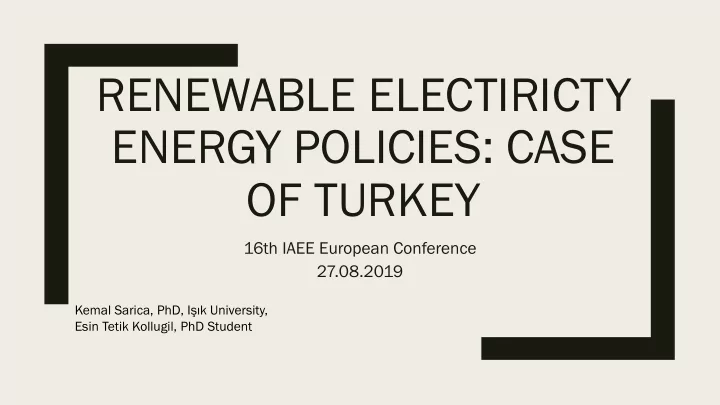

RENEWABLE ELECTIRICTY ENERGY POLICIES: CASE OF TURKEY 16th IAEE European Conference 27.08.2019 Kemal Sarica, PhD, I şı k University, Esin Tetik Kollugil, PhD Student
Outlook ■ Scope ■ Energy Outlook Turkey ■ Policy ■ Methodology ■ Results ■ Conclusion
Scope of the study ■ The focus of this study is to assess the potential CO 2 abatement through renewable energy policies within the economy ■ Benchmark the effects of policies compared to equivalent emission tax policies ■ Report the cost of policies analyzed
Energy Outlook Turkey ■ Fast increase in energy consumption due to – Urbanization and – Relativley high population growth : Average population growth rate between 1990-2017 1.4% per year. – Dynamic economic activity: Average GDP Growth rate between 1990-2017 4.5% per year
Energy Outlook Turkey ■ Primary Energy Consumption for year 2015 is roughly 5407 PJ. ■ 87% of primary energy consumption is from fossil resources. ■ 35% of primary energy consumption is consumed by electricity sector. ■ 80% of electricity fuel consumption is fossil based fuels ■ Only 5% of the electricty produced is based on intermittent/non-dispatchable resources (e.g. Wind and solar)
Policy - YEKDEM ■ The law became valid in 2005. Price guarantee applicable for ten years after the generation facility becomes operational by the end of 2020. ■ Solar electricity is subsidized for 13.3 ¢/kWh ■ Wind electricity is subsidized for 7.7 ¢/kWh
Policy - Alternatives ■ Continuum of the current YEKDEM subsidies. ■ An equivalent feed in tariff to YEKDEM share of intermittent generation ■ An equivalent emission level to YEKDEM tax policy ■ A feed in tariff targeting 15% intermittent generation share by 2030 ■ An equivalent emission level to 15% intermittent generation share by 2030 tax policy
Methodology ■ IEA TIMES modelling framework has been utilized ■ Bottom-up, perfect foresight model ■ Maximizing total surplus of the consumers and producers ■ Linear optimization model ■ Partial equilibrium model
Methodology ■ Model covering electricity, industry, transportation, buildings and refinery has been developed ■ Model with 582 commodities, 792 Technologies and 209000 data values ■ 288 timeslices (24 hours for each season) has been deployed to assess the impacts on the hourly time slices. ■ Base power plants flexibility has been limited (e.g. Nuclear, coal, lignite) ■ Modelling time horizon has been selected as 2015 to 2035. ■ Model calibrated based on 2015 energy balance
Results Reference 2500 2000 1500 PJ 1000 500 0 2015 2018 2020 2023 2025 2030 2035 Coal Lignite Oil NaturalGas Hydro Nuclear Solar Wind Geothermal Municipal Waste
Results Reference 100% 90% 80% 70% 60% 50% 40% 30% 20% 10% 0% 2015 2018 2020 2023 2025 2030 2035 Coal Lignite Oil NaturalGas Hydro Nuclear Solar Wind Geothermal Municipal Waste
Results Continuum of YEKDEM 100% 90% 80% 70% 60% 50% 40% 30% 20% 10% 0% 2015 2018 2020 2023 2025 2030 2035 Coal Lignite Oil NaturalGas Hydro Nuclear Solar Wind Geothermal Municipal Waste
Results 15% Intermittent Target Feed in Tariff 100% 90% 80% 70% 60% 50% 40% 30% 20% 10% 0% 2015 2018 2020 2023 2025 2030 2035 Coal Lignite Oil NaturalGas Hydro Nuclear Solar Wind Geothermal Municipal Waste
Results Electricty Prices 20 18 16 14 million USD / PJ 12 10 8 6 4 2 0 Reference YEKDEM Continuum Eq. Ems Tax YEKDEM Continuum Eq. Feed in Tariff Yekdem Continuum
Results Electricty Prices 30 25 million USD / PJ 20 15 10 5 0 15% Intermittent Penetration Eq. Ems. Tax 15% Intermittent Penetration Eq. Feed in Tariff
Results 2030 System Annual Cost Emission Level Intermittent Average Mitigation (billion USD) (million ton) Generation Share Cost ($ / ton CO 2 ) Reference $ 386.72 578.44 4.3% YEKDEM Continuum $ 388.11 566.00 7.2% 112.45 YEKDEM Continuum Feed in Tariff $ 387.45 565.23 7.2% 55.67 15% Intermittent Target Tariff $ 389.66 528.02 15.0% 58.37 YEKDEM Continuum Eq. Emission Tax $ 386.74 566.00 4.4% 1.99 15% Intermittent Target Eq. Emission Tax $ 386.94 528.02 11.0% 4.43
Conclusions ■ Direct subsidy of renewables can help to reach higher level of penetration, leading lower emission levels. ■ However, efficiency of the subsidy policy is questionable. ■ Instead of direct subsidy feed in tariff is shown to be more cost effective for the same level of intermittent generation. ■ For the same level abatement level carbon pricing is found to be the most cost effective policy option. ■ For Turkey to achieve INDC targets carbon pricing is the most suitable option to have the least impact on the economy.
Thank you for listening! ■ Contact : Kemal Sarıca ■ E-mail: kemal.sarica@isikun.edu.tr
Recommend
More recommend